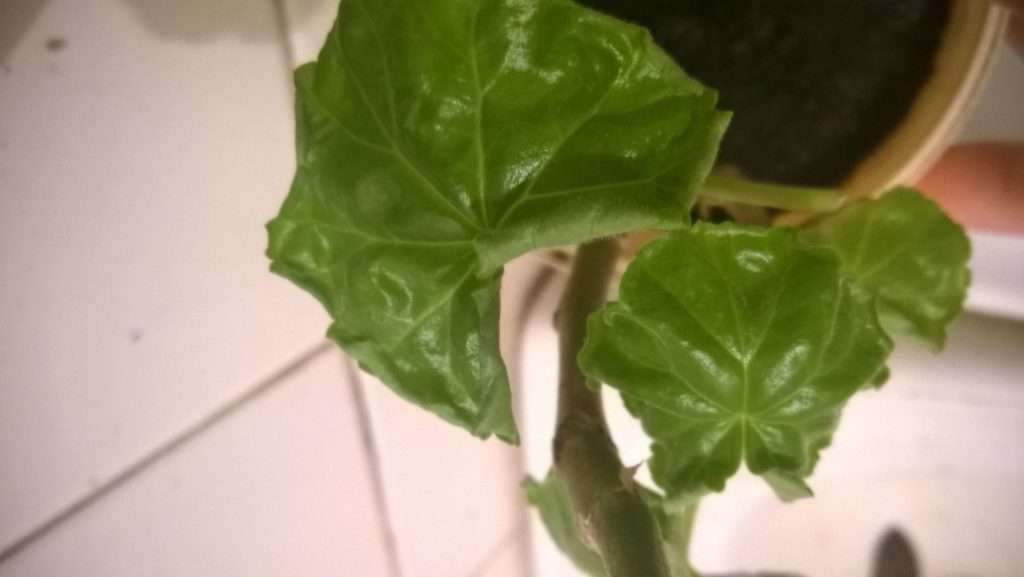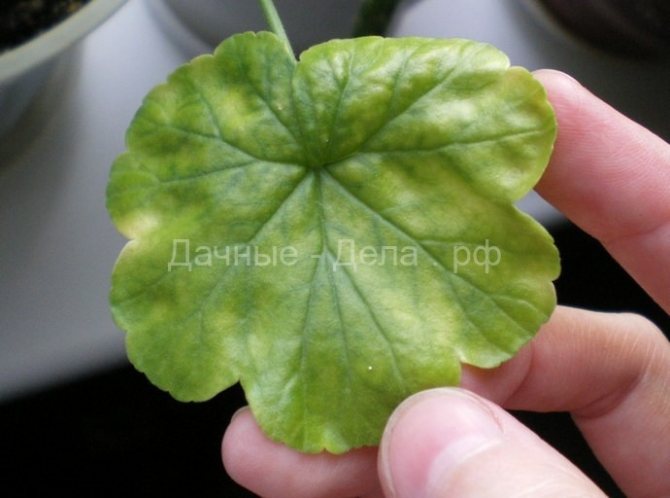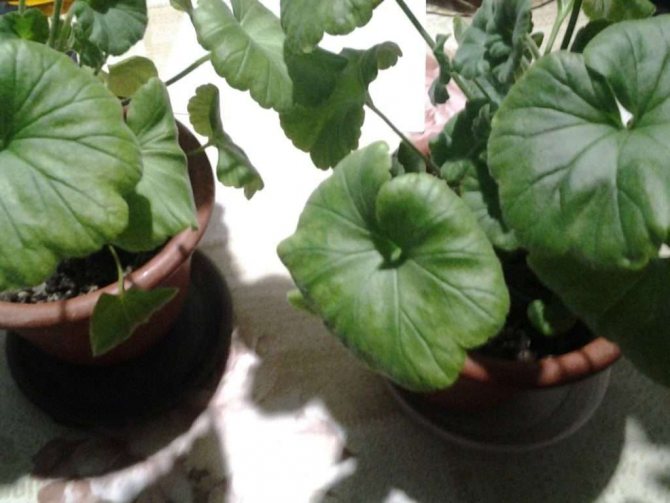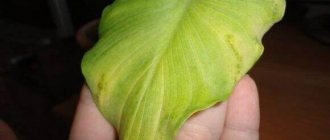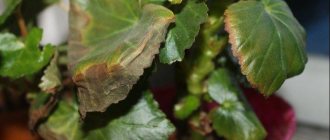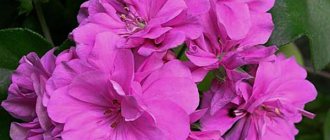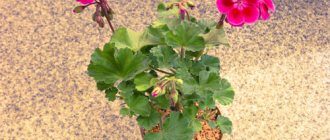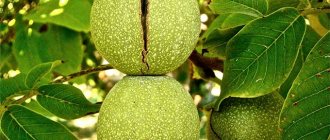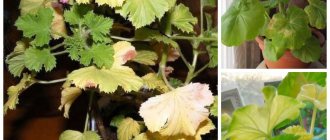Geranium or pelargonium is the most beautiful flower that gardeners have been increasingly purchasing lately. Often this is due to the particular unpretentiousness of the plant, as well as its resistance to many types of diseases. The latter is possible due to the fact that the leaf plates contain phytoncides and alkaloids - protective components (and they are very bitter) that repel many pests. Novice flower growers, knowing that a flower does not need much care, actively plant it and breed it, decorating the windowsills of their own apartments.
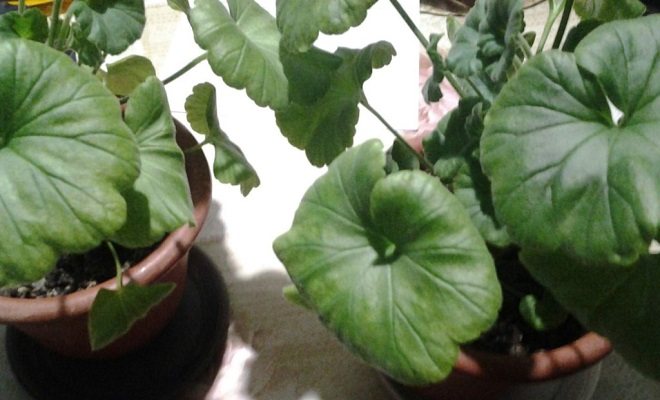
However, noticing that the leaves of the geranium are curling inward, gardeners, in bewilderment, begin to shrug their shoulders, how and why this could happen. This will never happen with a healthy flower, and if so, then it is necessary to deal with the causes of twisting of the leaf plates and methods of eliminating the problem.
Reasons why geranium leaves curl
To begin with, the flower is examined in order to understand the reason for this phenomenon and to deal with its early elimination.
The error can be at any stage of plant care:
- Wrong choice of soil.
- Lean or excessive watering.
- Incorrect temperature and humidity.
- Lack or, conversely, excess of fertilizers.
- Damage by pests and viruses.
Improper watering
The state of the leaves of geraniums directly depends on the amount of moisture received. Trying to retain fluid inside itself, the plant reduces the size of the leaf plate. On average, watering should be carried out every 3-4 days in summer, during which time the topsoil becomes dry.
Watering should be done with clean, settled (within 1-2 days) water at room temperature. Lemon juice or acid is added to soften it. Per liter 2-3 drops or 1 g.
Hard water contributes to the accumulation of excess calcium in the soil and causes yellowness.
Excess water also adversely affects the state of greenery. Leaves change color, their edges dry out, and the plant rots or becomes lethargic. To prevent this from happening, when planting, you must remember about the drainage at the bottom of the pot. Loosening the soil, at least once a month, will help the roots get oxygen more easily. And the liquid will better pass into the lower layers of the soil, and is removed through the holes in the bottom without stagnation.
In the autumn-winter period, geraniums are dormant, so you need to water less often, 2-3 times a month. If the plant does begin to shed its leaves and the roots rot, the solution is to remove the spoiled roots and completely replace the soil in the pot.
Soil selection, feeding errors
For planting, you can buy special or universal soil in the store. Or compose it yourself.
The main condition is that the land should not be hard and heavy, the flora is neutral or slightly acidified. Mandatory components are sand and peat.
As the soil is depleted, mineral fertilizers are applied. Particular attention is paid to nitrogen, which is responsible for the formation of greenery and abundant flowering. Its deficiency will be first and foremost signaled by the leaves, becoming thin, yellow and faded.
And also a color change can be due to:
- Lack of boron.
- Calcium deficiency.
- Lots of potassium.
An excess of fertilizing is also harmful, so it is necessary to choose the right fertilizers and carefully measure the doses indicated in the instructions for the preparation. Optimal schedule: once every 2 weeks.
If the plant has been transplanted recently, you need to feed it after two months.
Some growers plant geraniums outdoors in summer. In the fall, when transferring to a pot, it is better not to take soil from the garden, in order to avoid infection with fungus or pests. It is optimal to purchase ready-made soil in the store.
How to resurrect a geranium if it is hopelessly spoiled
Yellowed leaves cannot be reanimated. Consider they are already dead. There is no way to make yellowed geranium leaves green and fresh again. Therefore, boldly cut off the yellowed leaves. Don't expect them to turn green again.
Note. This rule does not apply to faded geranium leaves, deprived of sunlight for a long time. Even almost transparent leaves will turn into a juicy green if the plant is provided with the necessary minimum of lighting.
Pruning and grafting
The most radical way to deal with yellowed leaves is by pruning. If you see that the geranium is in a hopeless state, the stem is stiff and elongated, the lower leaves are missing, there are only miserable bunches of leaves at the top, the soil is no good, cracked and dry, you can resort to pruning.
Cut off the tops and place each in a glass of clean water. Make cuttings about 10-15 cm long. If there are inflorescences, you can cut them off and discard them so that they do not draw off the force from the cutting. But geranium is so powerful that it can take root even during flowering.
Pour water into glasses for a week or two. Small white roots should appear on the cuttings.
Prepare new clay flower pots with a volume of 1-1.5 liters, fill them with a mixture of sand and fertile slightly acidic soil, spill with a weak solution of manganese and plant prepared cuttings for rooting. After 3-4 months, you will have a fresh young geranium, which will delight you for many years with proper care.
Indoor geranium is a beautiful and healthy plant worth taking care of. It is believed that geranium drives away envious and evil thoughts, helps restore immunity and good health.
A large pot of geraniums was always placed in the bedrooms and in the nurseries, so that the plant would delay diseases on itself. If the geranium is withering, it is possible that something is wrong in the house. Blooming lush geraniums on the windows are a sign of the health and well-being of the inhabitants.
Novice flower growers often contact us with different questions, and we answer them whenever possible. Some of these questions are: Why does geranium turn yellow? geranium turns yellow - what to do? Why does geranium dry? Why does geranium turn yellow and dry?
You will find the answers to these questions in our article.
Incorrect containment conditions
Due to incorrect readings of humidity and temperature, short daylight hours, tight or too free capacity, the sheet plate changes its shape or color.
Lighting
Pelargonium loves well-lit windowsills. But it needs to be shaded from direct sunlight, because of which the leaves will get burned. In the winter-spring period, the flower, on the contrary, is placed in the "sunniest" place.
Temperature
In autumn and spring, it is better to keep pelargonium on a glazed balcony. The main condition of keeping, the air should not be very cold + 10 ... + 12 ° C.
Optimal performance:
Season
Temperature
Humidity
Geranium does not tolerate air dried out by heating devices poorly. To avoid leaf fall, it is best to purchase a humidifier or use a spray bottle. But you need to spray the liquid not on the plant, but at some distance from it.And also the problem will be solved by a container with water or wet expanded clay, placed next to it.
It is better to place the pots away from batteries and ventilate the room once a day. But this must be done carefully, because the plant does not like drafts. It also loses moisture from the surface of the leaves, as a result, they curl.
Tight pots
The container in which the pelargonium grows should not be small. If the roots become cramped, this will affect the appearance of the foliage. It will begin to dry and lose color. If the pot is large, then the forces will be directed to the growth of the root system, but the flowers will not appear soon.
A plant planted in an oversized container is transplanted. This must be done carefully, because the yellowness of the foliage can be provoked by damage to the roots.
If the pot is changed during the flowering period, then the peduncles are removed.
Pests and diseases
Geraniums are rarely affected by pests due to the bitterness of the juice, but there are those that still settle on stems and greens. For example, a spider mite can be seen with a magnifying glass on the back of the leaves, which are covered with a transparent cobweb, dry and curl inward.
Why does geranium turn yellow?
Appearing in the house, pelargonium pleases the owners with its beauty and rapid flowering. The plant has a positive energy, helps to fight depression, disinfects the air. In addition, the beneficial properties of geranium flowers have long been known.
Their broth is used to treat various diseases, such as otitis media, sciatica. Therefore, if the leaves of the flower turn yellow and begin to gradually fall off, it is necessary to take emergency measures to save the pelargonium. Having studied the information on the Internet and guides on floriculture, we have identified the following possible causes of yellowing of leaf blades:
Small and cramped pot. The rules are well known according to which it is not recommended to plant geraniums in a large container in order to avoid its excessive expansion in breadth. Therefore, many flower gardens go too far and choose an overly narrow pot for their favorite plant. A small vessel prevents its roots from growing.
Improper flower care in the winter. Winter is a dormant period for the plant. At this stage, he does not need abundant watering. Excessive moisture can lead to yellowing of the pelargonium. Also, in the cold season, the optimum air temperature for geraniums is 10-12 ° C. The plant does not like drafts and placement close to radiators, because overheating of the air causes an abundant loss of moisture.
An excess of moisture leads to the fact that the upper leaves of the plant turn yellow, wither and rot.
Lack of fluid provokes yellowness of the lower leaf plates. They dry from edge to center and gradually fall off.
Rust of the leaf. This is a fungal disease, which is accompanied by the appearance of rusty spots on the sheets and pads with spores inside them. They are thrown away, contributing to the further spread of the disease.
Excessive amounts of organic fertilizers. The plant should be fed, following the instructions on the packaging of the drug and recommendations for caring for this representative of the flora. In summer, you can often fertilize pelargonium using substances with a high potassium content in them.
When a flower is transplanted or transferred from the street to the house, it acclimatizes within 2 weeks, accompanied by yellowing, which usually goes away on its own.
Exposure of pelargonium to direct sunlight leads to leaf burns and the appearance of yellow spots on them.
Geranium leaves turn yellow, what should I do?
The measures taken in time will help save the geranium and return it to its former beauty, and then it will delight you with its appearance for a long time.
Mr. Summer resident advises: how to avoid leaf twisting in geraniums
It is much easier to prevent a dangerous illness than to fight it. Therefore, prevention will be the main advice.
Measures to prevent curling and yellowness of leaves:
- Regular, but not intensive watering.
- Mandatory inspection of the plant and treatment from pests.
- Optimum indicators of temperature and humidity.
- Comfortable and cool wintering. Regular ventilation of the room.
- Timely feeding. Strict adherence to instructions and adherence to the doses indicated on the drug labels.
- Choosing a suitable pot and light-colored windowsill without direct sunlight.
- In the warm season, take out into fresh air.
By following the recommendations and creating optimal conditions for growth, even a beginner will grow healthy pelargonium at home, which will delight with abundant flowering and caps of dense greenery. After all, a strong plant is much less likely to be susceptible to viruses and pest attacks.
Geranium is famous for its unpretentiousness, but sometimes flower growers still notice that the leaves of the plant curl and turn yellow. To avoid this phenomenon, before buying a flower, you should study the simple rules for caring for pelargonium.


High humidity
High humidity in the room where geranium grows can cause the development of fungal infections. Often the plant is covered with rust, while yellow-brown spots form on the leaves, which then dry out. This disease is difficult to fight. Multiple treatment of the bush with antifungal drugs is required.
Do not specifically increase the humidity level, spraying is very harmful to geraniums
... If water gets on the leaves, rotten areas may develop, which will dry out over time. The affected leaf will turn yellow and fall off.
Geranium stems and leaves need dry air to keep them healthy. It is helpful to ventilate the room to reduce humidity. You can take the bush outdoors in the garden in the summer.
Incorrect landing or transplant
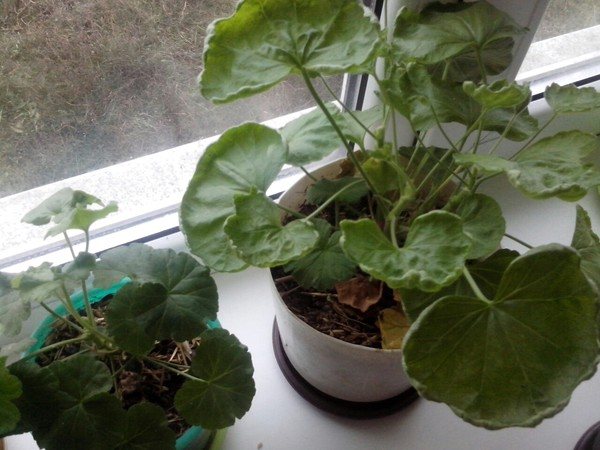

The reason why they turn yellow and gradually die off may lie in the wrong pot. If too small a container is chosen, especially for an adult plant, then the geranium may not have enough volume for root development. But when choosing a pots, it is important not to overdo it - if the size of the container is too large, all the power of the flower will go to the growth of the roots, and you will not wait for flowering soon.
If the pot does not fit your flower or there is not enough drainage in it, you should immediately transplant. If at this time pelargonium blooms, then all peduncles must first be removed. When transplanting, act as carefully as possible, since yellowing of the foliage can be triggered by damage to the roots when "moving" to another pot.
How to prevent the problem?
For to prevent the appearance of wilted leaves, all negative factors should be eliminated, re-read the basic rules for caring for geraniums, set up an orderly schedule of watering and feeding the plant. After all, coping with diseases and their consequences is not always easy. Better not to let this happen.
When it is correct to follow the above instructions, to devote more time to your favorite indoor plant, then geranium will delight you with lush, juicy foliage and bright flowers for a long time. And her aroma will soothe and tune in to the positive of all households.
If you find an error, please select a piece of text and press Ctrl + Enter.


Mineral deficiency


Leaves can curl up due to a lack of various substances. Even if the plant was planted in soil rich in trace elements, their number in it quickly decreases.
Geranium must be fertilized regularly using complex mineral fertilizing. This is especially true during the growing season, when pelargonium spends a lot of energy on the growth and formation of inflorescences. But it should be borne in mind that an excess of nutrients has a detrimental effect on the appearance of the flower, so they should be introduced according to the instructions on the package.
Excess or lack of nutrition
Top dressing plays an important role. If there is none at all, then the plant suffers from a lack of minerals and begins to wither. If it is excessive, then geranium often stops blooming, it can drop leaves.
Lack of nitrogen leads to curling of the lower and middle leaves. This element is essential for the beautiful appearance of the plant. Thanks to him, geranium leaves look healthy, juicy, green, the plant is actively growing and developing. Due to a lack of nitrogen, the state of the leaves deteriorates - they wither, become thinner, curl up into a tube.
Observe the measure. From an excess of nitrogen, the plant often stops blooming. All the power goes into the formation of a dense green crown to the detriment of flowering.
Potassium is an equally important element in the life of a plant. It is necessary for the full growth and development of geraniums. At the same time, an overabundance of potassium in the soil leads to leaf deformation.
If you recently fed geraniums and it was after this that this problem appeared, most likely the matter is in the nutrition of the flower. Stop feeding and rest the plant.
Temperature and humidity
Too dry air does not benefit pelargonium, so it should be placed away from heating appliances. If there is insufficient air humidity, you can put a jar of water or wet expanded clay next to the plant.
Choose a location that is protected from drafts, to which geraniums are very sensitive. It is important to ensure that the temperature in the room does not drop below 10 - 12 ° C. In the autumn and spring months, it is better to keep the plant on a glazed loggia, if the temperature there does not fall below the specified mark.
Low temperature content
Signs.
The border on all leaves is first red, then turns yellow and dries.
Decision.
The normal temperature range of geranium content is from +15 to + 24 ° C. A lower reading of the thermometer is completely uncomfortable for the plant. The cold season is especially rich in unpleasant surprises. Hot dry air comes from the heating radiators, and cold and damp air blows from the window. It's no wonder that geraniums get sick.
Move the pot to a more comfortable place with an acceptable temperature and normal air humidity. If this is not possible, then do the following:
- Batteries under the window are covered with a thick towel or blanket. Better wet. This eliminates excessive dryness of the air.
- Cold glass is fenced off from the pot with a sheet of foam or a strip of foamed insulation. Even a piece of cork hot plate, a piece of thick woolen cloth, will do.
- The same materials are placed under the pot to insulate the root system.
- Place geraniums on the windowsill so that shoots and leaves do not touch the glass.
As you can see, the procedures are not that complicated, and the benefits from them are enormous.Thanks to these actions, the temperature of the geranium content on the windowsill evens out in winter. She is close to the room and does not hesitate from drafts from the window. The leaves will stop turning yellow and dry.
how to water aloe at home
Violation of watering rules
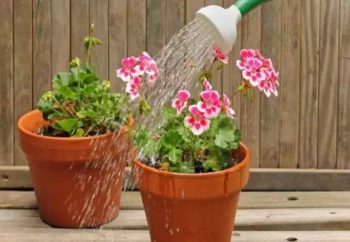

If the water for irrigation is too hard, calcium accumulates in the soil, and geranium signals this by yellowing of the leaf plates. Therefore, it is necessary to water the flower only with water that has been settled for several days, into which you can add a few drops of lemon juice. In the warm season, it is necessary to water the plant more often, making sure that the earthy clod does not dry out.
Excess moisture also negatively affects the condition of the geranium. In addition to rolling the leaves, in this case the lower leaf plates rot and the whole plant becomes lethargic. Experienced growers say that it is better to underfill the geranium a little than to fill it, since it tolerates drought better than stagnant moisture.
Watering should be moderate, especially during the winter. At least once a month, the soil should be loosened for better air access to the plant roots. Loosening is also necessary in order for moisture to reach the root system better: if the soil in the pot is "stone", then even abundant watering will be less effective. As a result, the leaves curl up - in this way the geranium tries to reduce water consumption.
Lack of a dormant period
Geranium should not grow in winter. It hibernates at low temperatures and rests before growing and flowering in the spring.
Geranium does not bloom without a dormant period!
If the plant is kept at room temperature in winter, it will very quickly become ugly elongated. After all, in winter there is always not enough light for its development, therefore, if geranium grows in winter, it stretches and. And along with this, it loses its leaves. Providing the plant with a dormant period will help avoid this.
At this time, it is already required to prune geraniums. After all, geranium is photophilous, and in winter there is little light, and the plant stretches out, becomes not very beautiful.
In geraniums, you need to cut the bare shoots to the height that you need (but not quite to the stump, of course), new branches will go from them.
And you can renew the geranium every year by replanting from a new cuttings, as our great-grandmothers did in the old days.
For propagation of geraniums, apical cuttings about 7 cm long with 3-5 leaves are suitable.
Cut the cuttings, making an oblique cut under the bud, cut off the bottom pair of leaves, dry the cut and the place where the leaves break for 2-3 hours so that the cut is tightened with a film, and plant immediately in prepared pots with soil, lightly water.
To form a lush bush, pinch the apical bud. We put in a bright place, but not in the sun!
Many simply cut the cuttings and put them in water, you can put activated carbon tablets in a jar of water so that there is no decay.
Roots form very quickly. Then they are placed in pots.
You need to take a small pot. You don't need a lot of geranium land. The faster the roots cover a clod of earth, the faster the plant will bloom, and the smaller the pot, the more abundant the flowering will be.
In large pots, the plant may not bloom at all, it does not need it - life is so good, why bother? You can even plant several cuttings in one pot.
In the process of rooting, the lower leaves may turn yellow - tear them off when a couple of new leaves appear.
To form a beautiful lush bush, pinch the top on the 8-10th leaf, the side shoots - on the 6-8th and constantly turn the pot so that the bush is even.
Geranium likes:
- the sun (but also tolerates a light shade);
- warm (but will survive very light autumn frosts);
- not frequent, but abundant watering;
- good drainage in the pot;
- moderately fertile, even poor soil (otherwise there will be a lot of greenery, but few flowers);
- regular feeding;
- removal of faded inflorescences to continue flowering.
In June-July, if necessary, cuttings can be made.
Iodine water is a very good feeding: dissolve 1 drop of iodine in 1 liter of water and pour 50 ml of this composition along the walls of the pot. Do not overdo it so the roots do not burn!
After such watering, geraniums bloom continuously and gorgeous!
If the leaves turn yellow, the reasons may be as follows:
- if only the edges of the leaves dry out - the reason is a lack of moisture;
- if the leaves are lethargic or rotting - the reason is excess moisture.
In both cases, the leaves may fall off. Exposure of the stem, the lower leaves fall off - lack of light. In summer, geraniums are very fond of living in the fresh air - take it to the balcony or garden, plant it well in the ground.
At first, having survived the stress associated with a change of place, geranium will hurt, its leaves may turn yellow and fall off. But then she will delight you with abundant flowering.
On the street, geraniums bloom amazingly, and the bush grows strongly in a way that never before
In the sun, sometimes geranium leaves turn pink - this is a normal phenomenon, like a "tan", the plant is no better, no worse.
In autumn, when the weather is cool at 10-12 degrees, geraniums "go crazy" from such a temperature!
You can keep geraniums outside until the frost begins, until the temperature drops to + 2-5. Then it will need to be cut, transplanted into pots and placed in a cool place (10-12 degrees) for hibernation, or, gradually accustoming it to a higher temperature, brought into the room where it will continue to bloom.
There is an opinion that pelargonium never gets sick, and pests are not afraid of it. But still, there are times when the plant starts to feel bad. What could be the reason?
It happens that the leaves of pelargonium begin to turn yellow and fall off, after which the plant completely dies in a matter of days. To accurately determine the disease, you need to take a closer look at the symptoms.
Diseases of pelargonium
1.
Bacterial spot
... The warm and humid microclimate causes the bacteria Xanthomonas campestris to appear on the plant. Because of them, the leaves of pelargonium turn brown and fall off, and black rot may appear on the stems.
How to avoid:
Check if the seedlings are infected. Leave free space between the plants when planting. Water the pelargonium in the morning, do not splash the water around. Look at the leaves more often, delete the suspicious ones. If there are signs of a disease, treat the plants with copper sulfate.
2. Black leg
and / or
black stem rot
... This is usually a disease of the cuttings, but sometimes signs of damage can be found on adult specimens. First, the stem turns black at the base, and then the disease gradually "rises" up.
How to avoid:
Only remove cuttings from healthy plants. Do not water the pelargonium for a couple of weeks before pruning. Before planting, spill the soil with boiling water with the addition of potassium permanganate. Infected cuttings can be saved if they are treated with a fungicide in time.
3. Gray rot
... Spots appear not only on the leaves, but also on the petals. The gray mold fungus develops on pelargoniums that grow in too cold and damp rooms. If at least one diseased specimen appears in the collection, then soon it can infect all nearby plants.
How to avoid:
Inspect your plants regularly. Keep the pots some distance apart for good ventilation. Place the pelargoniums in a bright, dry place. If a gray-brown coating appears, treat the plants with a fungicide
Pelargonium is sick
4. Rust
... Most often, this disease affects zonal pelargonium. At the same time, spots appear on the leaves: yellow - on the upper part of the plates, brown - on the bottom. After a while, the leaves are deformed and fall off. The fungus also affects stems and petioles.
How to avoid:
Inspect flowers regularly. The disease can come to you with a sick "newbie" brought from the store. Treat new pelargoniums with a fungicide and keep them in quarantine for the first time.
Pelargonium pests
When growing pelargonium in flower beds, there is a chance that the plant will be interested cabbage caterpillars
... They can be collected by hand or treated with 70% vinegar essence (1 tablespoon) diluted with 10 liters of water.
Colonies can settle on the underside of the leaf plategreenhouse whitefly
... To get rid of this pest, it is enough to spray the leaves of pelargonium with water: the larvae are washed off, and the butterflies get wet and die.
At this time, it is already required to prune geraniums. After all, geranium is photophilous, and in winter there is little light, and the plant stretches out, becomes not very beautiful.
In geraniums, you need to cut the bare shoots to the height that you need (but not quite to the stump, of course), new branches will go from them.
Geranium can be found in almost every home. Such popularity of the flower is due to its beauty and medicinal properties. However, its growth is often accompanied by a host of problems and ailments. About what diseases occur in geraniums and their treatment with a photo in detail in this article.
Geranium, or scientifically based pelargonium, is prone to a variety of diseases and disorders:
- Yellowing of the leaves;
- Lack of flowering;
- Drying of leaves;
- Mushroom Botrytis;
- Root rot;
- Rust of the leaf;
- Bacterial disease;
- Viral infections;
- Spotting of leaf blades;
- Edema.
The first three points on this list are more likely to be related to the results of violations in the care, therefore, to eliminate them, it is enough just to restore the correct handling of the flower.
Diseases and pests
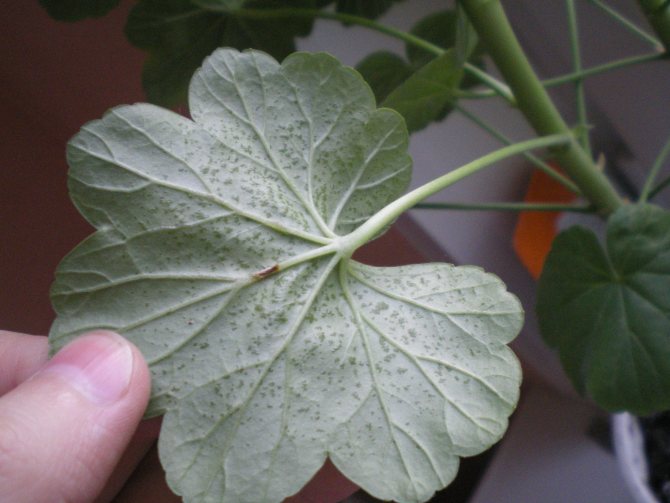

Geraniums can attack spider mites, causing the edges of the leaf plates to curl inward. This pest is very small, therefore, to identify it, the leaf plates must be examined from both sides through a magnifying glass. Sometimes whiteflies and aphids settle on plants. To control insects, rinse the plant and treat with an insecticide. It is better to carry out several treatments at a certain interval indicated on the package with the drug.
More dangerous is a viral infection, in which the leaves are deformed and become clumsy. If the plant is struck by this attack, it is better to discard the geranium in order to prevent infection of the rest of the indoor flowers.
Whitish bloom or spots on the leaf plates signal a fungal disease, the defeat of which can also be accompanied by leaf curling. If you notice this phenomenon, geranium must be urgently sprayed with Bordeaux liquid. After this procedure, the spots will begin to disappear and the leaves will return to their original shape.
If root rot occurs, it will not be possible to help the plant, it will have to be thrown away. To keep the roots from rotting, water in moderation.
Pests can initially be found in the soil, which is collected in the garden or in the park. There may be the larvae of various insects, earthworms, etc. Therefore, it is better to buy land in specialized stores.
The following drugs are effective for pest control:
- Aspirin. It is dissolved in water in a ratio of 1 tablet to 10 liters. Leaves should be sprayed once a month.
- Marathon. It helps well against whiteflies and aphids. The dry matter must be scattered around the geranium, then well poured with water. Processing is carried out once every 30 days.
- Messenger. Dissolves in water according to instructions and is used to water the plant.
- Monterey. Effective when caterpillars appear. It must be dissolved in water and sprayed on the whole plant.
Soil composition
The optimal soil for geraniums is neutral or slightly acidic; peat and river sand should be present in the composition. If you make the soil mixture yourself, using soil from the garden, then disinfect the soil and add humus and mineral fertilizers there.
Dry the edges of the leaves
If dry areas appeared at the edges of the leaf plates, then this was due to one of two reasons:
- Pelargonium is deficient in moisture due to lack of watering or due to the fact that the pot is too hot.
- The root system of the plant is damaged. Try to transplant a flower, but before planting it in another container, treat the roots in a solution of potassium permanganate. So that you don't have to buy a new plant, just in case, cut off the stalk and root it in water. Be sure to disinfect the tool you will use for grafting.
Prophylaxis
It is much easier to prevent leaf curling than to deal with it later. Preventive measures are reduced to the following:
- Sufficient but moderate watering.
- Optimal temperature and humidity conditions.
- Regular check of the plant for the presence of pests.
- If possible, create coolness for the flower in the winter.
- Feed regularly with complex fertilizers for flowering plants. It is not necessary to deviate from the instructions for fertilization, so as not to create a deficiency or an excess of minerals in the soil.
- Choosing the right pot that matches the size of the root system.
To make the plant feel good, do not forget to take it out into the fresh air in warm weather, and regularly ventilate the room when it is cool.
Geranium or pelargonium is the most beautiful flower that gardeners have recently acquired more and more often. Often this is due to the particular unpretentiousness of the plant, as well as its resistance to many types of diseases. The latter is possible due to the fact that the leaf plates contain phytoncides and alkaloids - protective components (and they are very bitter) that repel many pests. Novice flower growers, knowing that a flower does not need much care, actively plant it and breed it, decorating the windowsills of their own apartments.
However, noticing that the leaves of the geranium are curling inward, gardeners, in bewilderment, begin to shrug their shoulders, how and why this could happen. This will never happen with a healthy flower, and if so, then it is necessary to deal with the causes of twisting of the leaf plates and methods of eliminating the problem.
Geranium problems: unexpected yellowing of leaves
If you grow indoor plants at home, then you should definitely familiarize yourself with the rules for their care and reproduction. This knowledge will help you grow a healthy flower that will become a real decoration of your home.
One of the representatives of the flora, which can often be found on the windowsills of apartments, is geranium or pelargonium. Caring for a flower is quite simple, although any plant can sometimes get sick and require attention. Let's see why geranium leaves turn yellow? How to deal with this unpleasant phenomenon?
Watering errors
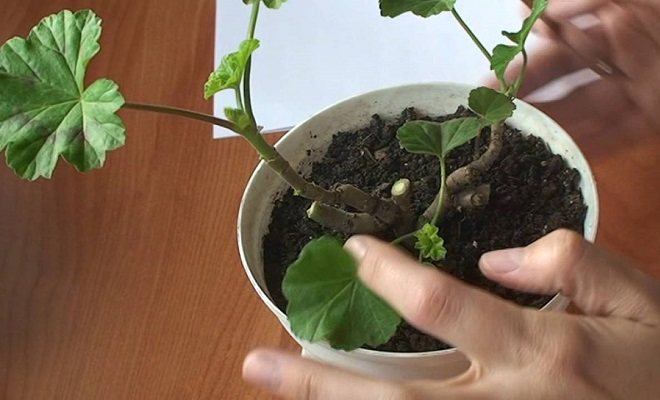

Lack of moisture, like its excess, harms the flower. Experienced gardeners note that it is better not to top up the plant than to pour it over. It tolerates drought much better. At the same time, if it was noticed that geranium leaves were curled up, this indicates that the roots have not seen water for a long time. Many novice flower growers, in principle, irrigate incorrectly - they poured water into the pot and that's it. And if the soil is stone inside, it has not been loosened for a long time, then it will be difficult for the liquid to seep inside and reach the root system. The water will sit on the surface until it evaporates. To prevent this from happening, you should loosen the ground at least once a month and make sure that the water remains on the sump after irrigation.
Water scarcity
Signs.
The leaves of geranium have a dry yellow border of a dark, almost brown hue. The pigmentation is visible throughout the plant.
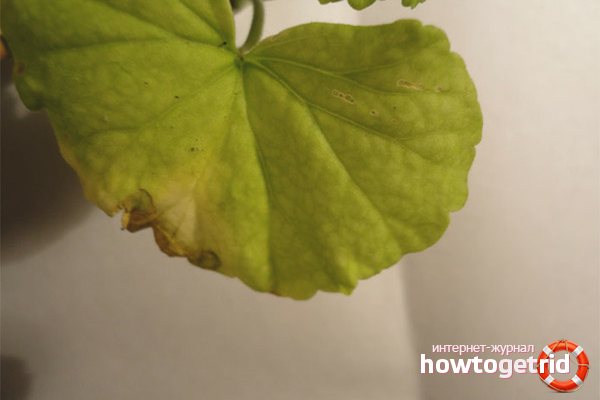

Decision.
Watering is described above. You should not rush from one extreme to another and completely dry out the earthen lump. Geranium is also a living plant, loves to eat and drink.Especially in summer and hot weather.
Don't have time to water the flower often? Place him in safer hands. Or change geraniums where the temperature is lower. This will allow moisture from the pot to evaporate more slowly, and the roots will not suck it in at the speed of the pump.
By the way, if there is a possibility, then in the summer you can not torment the beauty with a hot window sill, but transplant her directly into the open ground. Not in direct sunlight. Preferably where you most often run with a watering can or a watering hose. In the fall, you will not recognize your geranium. Instead of a stunted stick with yellowing drying leaves, a beautiful powerful bush with juicy green burdocks will grow.
Just do not plant it in the far corner of the garden or plot. You will definitely forget.
how to transplant a flower into another pot
Lack of feeding and fertilization
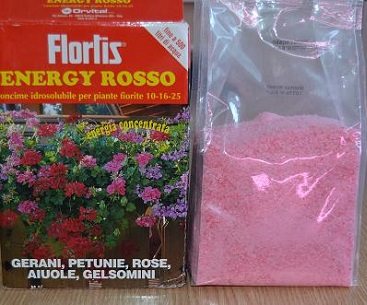

Poor soil is an indicator of the health of a flower. When composing the mixture yourself, you should remember that it should be light and loose. Peat and river sand must be present in the soil. In addition, it is important to add a little humus and mineral fertilizers.
After a while, the soil will begin to deplete, so it will be necessary to apply top dressing. Otherwise, the leaf plates may begin to turn yellow and curl.
Nitrogen plays a special role, providing good flowering and rich green color to the leaves. Its lack leads to the fact that the leaves become thinner, curl and wither.
Important! If fertilizing was introduced, and the situation is only getting worse, perhaps the reason lies in the oversaturation of the soil with fertilizers.
Measure should be in everything. The same applies to dressings. Leaving the geranium alone for a while, after a while the flower will recover.
If pelargonium was transplanted into the ground for the summer, and with the arrival of autumn, the florist returned it to the pot, while the land was taken from the garden, most likely there are earthworms in it or some larvae remained. All this will negatively affect the condition of the plant, so it must be transplanted again, but as a soil mixture, you will need to take either a special land purchased in a store, or compose it according to all the rules. Sometimes the soil infects a fungus, which can be seen by the characteristic bloom on the surface of the flower pot. In this case, one cannot do without replacing the land.
How to properly care for pelargonium leaves?
What exactly can be done so that geraniums, whose leaves turn yellow and dry quite often, acquire a healthy and attractive appearance? We offer the simplest but effective rules for caring for the crown of a plant, which will allow you to forget about problems with the flower:
By performing such a simple care, you will ensure that the crown of pelargonium will always be lush and attractive. A similar rule applies to yucca, which has a similar problem.
What other diseases can affect pelargonium?
The question of why geranium turns yellow is far from the most basic, problems often arise when the foliage is exposed to other diseases:
- brownish spots are a sign of bacterial disease.The edges become dry, dark streaks appear from the inside of the plate. For prevention, it is recommended to remove all affected areas, carefully monitor the state of soil moisture, do drainage;
- the so-called "rust" is a disease that is provoked by microorganisms. First, small yellowish specks and spore pads appear on the lower part of the leaflet. To prevent damage, it is necessary to constantly loosen the soil, not flood the plant, clean the soil surface from weeds;
- spotting also appears under the influence of the fungus. At first, these are small spots that form on the back of the leaves, over time they turn into ugly pits. To avoid the appearance of such a disease, it is necessary to periodically treat it with fungicides.
The situation when geranium leaves turn yellow can be caused by various reasons, but mostly these are the consequences of improper care. Therefore, it is necessary to properly care for the leaves and the flower itself, do not forget about the rules of watering and humidity. Diseases can also be triggered by pathogens, fungi, so the plant must be regularly inspected and preventive work carried out. In this case, your pet will grow beautiful and healthy!
Dry air and excess sunlight
Pelargonium is a light-loving plant, but at the same time it is afraid of direct sunlight. In summer, it is especially important to set the flower pot as far away from windows as possible. If this has not been done, then you will notice that the geranium leaves began to curl downward. In addition, burns may appear on the sheet plates. Dry air will not cause burns, but the leaves will suffer.


In the winter season, pelargonium should not be placed near heating devices, in the summer - near the "southern" windows. So that the flower does not suffer, it is advisable to irrigate it daily in the heat. In the absence of such an opportunity, you can put a bowl of cold water or ice next to the pot. Ideally, purchase a humidifier.
Causes of the phenomenon and their elimination
Natural cause of leaf death
Most often, geranium leaves turn yellow and dry with age. This is especially noticeable in zonal plants, the lower leaves of which turn yellow from time to time, dry up and die off. You will not be able to hinder the natural biological process of leaf aging, so just keep the geranium decorative by partial pruning of the stem in the spring, at the beginning of active growth. The procedure will speed up the appearance of new foliage.
The geranium plant does not like either cramped or spacious pots. The optimal container for it should be ceramic and have a diameter of 20-25 cm and a height of 12-15 cm. In plastic dishes, geraniums often rot roots,
therefore, vermiculite, perlite and well-washed river sand must be added to the universal soil for the plant: the substrate for geranium should be loose.
It is necessary to transplant the plant carefully, because due to awkward actions, the geranium may begin to fall out of leaves. This flower does not like changes at all, the slightest change in the usual conditions can cause stress in it, which is expressed by yellowing and falling leaves. If you need to rearrange the plant, do it gradually, moving it 2-3 cm every day, and then the yellow leaves may not appear.
Geranium loves direct sun, and this is its advantage over most indoor plants: it can be grown on southern windowsills. However, this plant also has a limit of endurance, so in extreme heat, when the sun becomes destructive, shade the geranium from its rays in the afternoon, from 12 to 16 hours. If you don't, falling leaves of yellow, dry leaves
will not keep you waiting.
Leaves dry at the edges and dark brown tips are a sign of low humidity in the room or that the leaves of the plant are touching the glass.Place containers of water around the geranium and move the pot away from the window.
Geranium is thermophilic and tolerates heat well, but from the slightest draft
covered with yellow leaves. The optimum temperature for a plant is 20-25 ºC in summer and 10-14 ºC in winter. When ventilating, make sure that the geranium does not come under the oncoming air currents. And keep the flower pot as far away from heating appliances as possible in winter.
Violation of the watering regime
The health and beauty of geraniums is highly dependent on the watering regime. Both lack and excess of moisture can cause irreparable harm to the plant. The state of the leaves will tell you how correctly the watering regime is drawn up, and you can correct it: the geranium turns yellow - the moisture was excessive, the geranium withers and dries - it means that the plant lacks moisture. If the dots and spots on the leaves are dry, the plant suffers from thirst, and if the spots are brown and wet, you have allowed the substrate to become overmoistened. Good drainage can protect geraniums for a while.
from the consequences of excess moisture in the soil, but if you water the flower incorrectly for a long time, then problems cannot be avoided.
Try to water your geraniums regularly. From spring to autumn, 2-3 waterings per week will be enough, and the water consumption depends on the weather outside the window: in the rain geraniums need less water, in the heat - more. In prolonged heat and drought, you may have to moisten the substrate every other day. In winter, the plant is watered twice less often. Irrigation water
must be at room temperature and soft, otherwise calcium will accumulate in the substrate, from which the upper leaves of the geranium turn yellow. Let the water stand for 2 days and sometimes add a few drops of lemon juice to it. When watering, no water droplets should fall on the leaves.
Geranium nutritional problems
Geranium does not need frequent feeding, therefore, from autumn to spring it is not fertilized, and from spring to autumn it is fed with potassium-phosphorus fertilizers. If the complex is dominated by the nitrogen component, this can lead to yellowing of the leaves. As for the balance of elements, the lower and middle leaves of the geranium turn yellow from the lack of nitrogen, potassium, phosphorus, magnesium and zinc. If there is a deficiency of boron, iron, copper, manganese, sulfur and calcium, then the upper leaves of the plant may turn yellow. Try to feed geraniums with a balanced complex mineral fertilizer containing all the trace elements it needs.
Spider mites are especially dangerous pests, which can be detected by the thinnest cobwebs, when they have already given more than one generation. If you are patient and persistent, you can win this difficult struggle, but if the tick does not leave, it is better to say goodbye to geraniums so that your other plants do not suffer.
Of the diseases that can affect geraniums, the most dangerous is viral infection
, from which growth slows down, the stems bend, white stripes appear on the flowers, and yellow or light green dots and spots on the leaves. If you find these symptoms on your geranium, it is best to destroy the plant immediately before the virus spreads.
From bacterial rot
the tips of the leaves dry, then dry brown spots appear on the plates. With the development of the disease, the entire leaf darkens, and the disease passes to the stem. The affected leaves must be removed and the peduncles must be cut off. If the substrate smells of rot, it is advisable to transplant the plant into fresh soil, after washing its roots in a weak solution of potassium permanganate or in a fungicide solution.
A fungal disease of geranium can cause considerable harm rust
, from which yellow spots and spore pads appear on the underside of the leaves. Then the leaves turn yellow and begin to fall off. Destroy rust pathogens with a fungicidal preparation.
On defeat botrytis
geranium leaves dry and become covered with fluffy spots of a radial or V-shape.Sore areas should be removed, and geranium should be treated with a fungicide solution. In the future, you need to adjust the watering of the plant.
If the geranium leaves first turn white, become dull, then turn yellow and wither, and the roots soften and stratify, then you are dealing with root rot
... Isolate the flower from other plants, remove damaged areas of the root system, hold the roots in a solution of Fitosporin-M, Alirin-B, Fitovlavin or their analogues and plant geraniums in a fresh substrate. Moisten the soil sparingly and at first use a weak solution of the listed drugs for this.
Geranium is affected by another incurable disease - verticillary wilting
... On an outwardly healthy plant, the leaves begin to fade and dry, but do not fall off, but remain hanging on the stem. Brown spots are visible on the cut of the stem. To prevent the disease from spreading to other plants, geranium must be immediately destroyed along with the substrate in which it grew. For prevention purposes, treat all your home flowers with Alirin-B or other drugs of a similar effect.
4 Rating 4.00 (6 Votes)
Your favorite geranium leaves turn yellow and dry? This means that you are improperly caring for the plant or that it has been attacked by dangerous pests or diseases. Below we have listed all the possible reasons for the yellowing of pelargonium, as this beautiful flower is also called, as well as methods that will help to quickly bring the plant back to life.
Inconvenient or small pot
The wrong pot is the mistake of most gardeners. Some believe that the container should be voluminous so that the flower is not cramped and does not have to be repotted regularly. This leads to the fact that geranium either stops blooming after a while, or does not bloom initially. The same problem applies to too small a pot. Florists read somewhere that frequent transplants are harmful, so they are in no hurry to replace the container, and at this time the roots are already sticking out of the drainage holes with might and main. The plant is cramped, and it shows this - the leaves of the room geranium fold and lose their color.
Important! The pot should be changed as the pelargonium grows.
Medicines for geranium
In the fight against geranium problems, the following medicines can be used:
- Aspirin It can be used to detect insects. To prepare the solution, you will need one tablet of medicine and 8 liters of water. The resulting composition must be sprayed with geranium leaves. The procedure can be repeated after 3 weeks.
- Marathon This drug is also designed to fight insects, but they need to water the soil. The procedure can be carried out a few days after planting.
- Messenger It is used to increase the plant's own immunity.
- Monterey. It is sprayed on plants when traces of caterpillars are found on it.
Geranium has long been considered one of the most useful plants. The healing flower is capable of killing a huge number of bacteria and treating a variety of diseases, from a common cold to purulent wounds. That is why quality care will allow its owner to create a healing atmosphere in his home.
Pests and diseases
All kinds of insects are reluctant to land on the plant, because it is "tasteless". True, this does not mean that the pests fly around the flower at all, some can still “settle” on geraniums. Often we are talking about a spider mite. To detect parasites, you need to carefully examine the plant. Especially carefully you should look at the lower leaf plates, where parasites settle. It is not difficult to notice them. We are talking about small bugs on the flower, dark spots on the leaves, tears on them and similar deviations, which should not be.
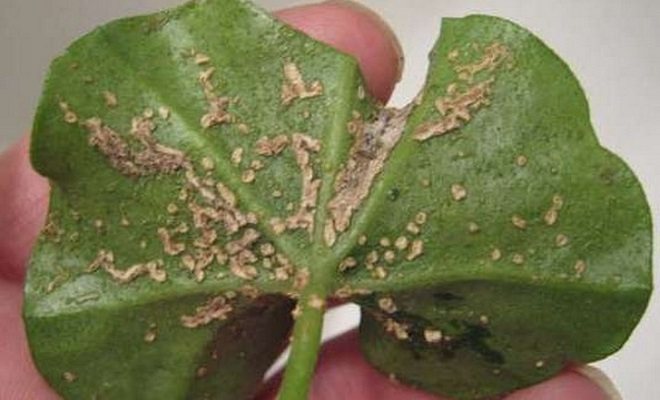

If something like that was noticed, it means that "uninvited guests" came to the geranium. The most important thing is to notice the problem in time and start fixing it.There are a number of drugs on the market today that are effective against a number of parasites. These are insecticides or chemicals. Having processed the flower several times, there will be no trace of the pests.
Lack of light
Signs.
Gradually, the lower leaves turn yellow and dry, the stem stretches, geraniums very rarely and bloom little.
Decision.
Change the place of residence of your young lady. Put it closer to the light or even hang additional lighting with phytolamps. Do not touch the leaves themselves. You can pinch the top of your head so the geranium grows wide. Otherwise, only a bare stem and a bunch of leaves on the crown will remain.
If you already have such a "miracle", then the best option would be cutting cuttings and rooting. Because new leaves will no longer grow on the stem.
how to make hippeastrum bloom
How to make a flower grow and develop
The flower will grow and bloom only where it is comfortable. If geraniums provided all the necessary conditions, then there will be no problems with it.
- Provide nutrients, lack of nutrition leads to wilting of geraniums.
- Keep away from drafts. The cold air flow will negatively affect the flowering and the general condition of the plant. Its roots can freeze and rot.
- Water regularly, but do not overfill. In the winter season, the frequency of watering is reduced to several times a month.
- Transplant from time to time, choosing a pot of the appropriate size.
In addition, it is very important to carry out preventive measures. If a transplant is planned, and it was decided to make the soil with our own hands, then all the components must be sterilized. This measure will protect from "uninvited" guests and various bacteria that may be contained in individual components. The flower should sometimes be checked for pests. Dry air negatively affects the plant, so you need to take care of its moisture.
Properly caring for pelargonium, you can admire its amazing flowering and juiciness of leaf plates for a long time.
Prevention
Almost all diseases and problems of pelargonium arise due to violations in care, therefore, to prevent them, it is enough just to follow simple rules:
- Observe the correct temperature regime;
- Control the humidity of the air and soil;
- Control lighting;
- Feed the soil regularly;
- Control the occurrence of pathologies in the plant;
- Fight insects.
Among insects, special attention should be paid to the spider mite, whitefly and aphids. They often appear in dry air and carry infections and viruses. If these insects were found in the room where the flowers grow, it is necessary to flush the plant and treat it with insecticides.
Excess moisture
Signs.
The leaves turn yellow at the tops of the shoots, then become lethargic, watery. The last stage is stem decay and leaf drying.
Decision.
Stop creating a swamp in your geranium pot. Check drain holes for clogged debris and overgrown roots. If this problem is relevant, then carefully remove the holes. Better yet, transplant the plant into another pot.
Water your pet correctly. Since geraniums are often placed on a sunny window, the topsoil dries out quickly enough, forming a crust. But it’s still humid enough downstairs. Many are too lazy to dig in the ground before the next watering and see what happens below the level of the crust. And the geranium is watered again.
Get in the habit of sticking a wooden skewer or sushi stick all the way to the bottom of the pot for 12-14 minutes. Then take it out and watch. On unpainted wood, the level of moisture in the ground will be clearly visible.
And further. Geraniums do not have a strictly regular drinking schedule. Water is given to the plant only when the soil in the pot is almost completely dry.
Preventive measures
To avoid geranium diseases, it must be monitored and properly cared for:
- sterilize the soil;
- water correctly, avoiding excess moisture;
- shade the flower so that it does not get sunburn;
- provide adequate lighting, avoiding direct sunlight;
- avoid drafts;
- maintain the air temperature in summer + 18-20 degrees, in winter - not lower than +10 degrees;
- monitor the humidity of the air, avoiding dryness;
- timely transplant into a pot of suitable volume.
Preventing geranium wilting
To prevent wilting of geranium foliage, you should provide it with proper care. The flower loves light, fresh air, good, but not excessive watering. During the hot season, it is necessary to move the plant to the shade. Top dressing should be carried out correctly, without overusing the amount of fertilizer. Don't forget about drainage, as geraniums are very sensitive to moist soil. It is also necessary to take into account the optimal temperature regime, which is in the range of 10-15 ° C. As the flower grows, the plant is transplanted into a larger container. In addition, it is important to timely get rid of diseases and pests that affect the flower.
Thus, geranium leaves can start to wilt for a variety of reasons. But timely measures aimed at saving the flower and proper care will help get rid of the problem.
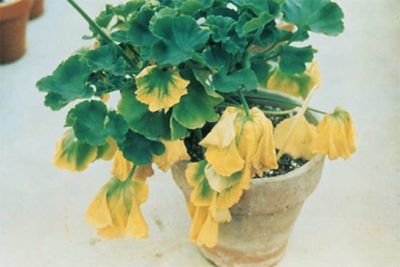

Geranium is a picky houseplant with a bright and abundant flowering. But even this beauty, unpretentious in care, can suddenly start to fade.
In this case, it is necessary to diagnose the cause of the disease in time and take the necessary measures to rehabilitate the tropical culture.
In this article, we will take a closer look at what this problem can cause. We will also show you how to correct the situation and avoid the death of the flower.
What to do in this case?


Provided that the necessary comfortable conditions are provided, geraniums can decorate a room all year round.
If the leaves of the plant for some reason began to curl up, the most important thing is to determine the reason for this state of the flower and act, starting from it. The main things to do:
IN PELARGONIA LEAVES TURN YELLOW AND DIE: PREVENTIVE MEASURES
It is much easier to prevent yellowing of the leaves than to cure an already diseased plant. In order not to have to fight to save your beloved geranium, you should:
- Transplant pelargonium in a suitable pot in time.
- Find a place for her, closed from drafts, with a sufficient amount of diffused light.
- Water as the earthen coma dries.
- Apply mineral complex fertilizers on time, suitable for flowering plants. The rates and schedule of application are indicated in the instructions for the tool. During the flowering period, it is recommended to do root dressing twice a month. Organic fertilizers will also be helpful.
- In winter, you need to try to keep the geranium cool.
- Regularly inspect the plant for infestation by pests, bacteria, fungi and viruses, providing treatment if necessary.
Yellowing of geranium leaves is an alarming sign. It is important to understand in time the cause of such a plant malaise. Having carefully examined it and analyzed the conditions of keeping pelargonium, you can find what provoked such a reaction. The sooner the mistakes are corrected, the less damage the geranium will do.
What to do and how to save the plant?
If this happens, and the beloved flower begins to wither, and the leaves wither, this is a signal for action.
- It is necessary to check whether the pot is suitable for geraniums, whether there is enough space, the roots do not protrude, whether there is drainage in it.If in doubt, transplant the plant into a larger container. Do not forget to use a special primer.
- Try to rearrange the flower on a window where there is more sunlight. If direct rays hit it, you need a temporary darkening.
- It is important not to flood the plant. The water in the pot should not stand. If this happens, you need to drain the excess liquid. When the soil is abundantly wet, decay processes develop, it is important to prevent this.
- Geranium does not tolerate temperature changes. Do not place it near heating appliances. In winter, the flower is removed from the windowsills so that cold air does not get on it. It is advisable to avoid drafts. The plant does not tolerate even slight frosts, but loves fresh air. If, in your opinion, this is the case, move the geranium to a place that is comfortable for it.
- Do not allow the soil to dry out in the pot. Especially in the summer, the plant needs to be watered abundantly. If, after watering, the leaves do not regain their shape, then the cause of wilting is different.
- When fertilizing geraniums, you must strictly adhere to the instructions on the package. After all, an increase in dosage can adversely affect the flower. In winter, fertilization is not necessary.
Errors when caring for room geraniums
Illiterate care is the main reason for the appearance of yellow leaves in "geraniums". This is an unpretentious plant to grow, but the basic rules for its development must be observed. Knowing the typical mistakes, it is easier to understand what your favorite indoor flower needs.
Wrong capacity
The choice of a pot for pelargonium must be approached very deliberately. Some novice growers in vain believe that the roots need a lot of space. But this is not suitable for all plants.
Indoor geraniums in a cramped container will quickly fill the entire space with roots and plant growth will slow down. As a result, the leaves will begin to turn yellow and dry. Using a very large flowerpot is also not an option. In a spacious pot, pelargonium will begin to intensively build up the root system, giving all its strength to this process. For this reason, flowering will be delayed.
Over a large area, there is a risk of moisture stagnation, which will lead to the development of rot.
Lack or excess of lighting
Pelargonium is a light-loving flower. It is better to place it on a windowsill where there is enough light. In the shade, a yellow border forms on the leaves, they will begin to dry out. But the direct rays of the sun are also detrimental to pelargonium. Brown burns appear from them.
Too much watering
Indoor geranium is a drought-resistant species, this should be taken into account when leaving. It is enough to water once a week. During hot summers, the frequency of humidification can be increased. The plant does not tolerate excess moisture. A characteristic feature is the appearance of yellowness on the foliage.
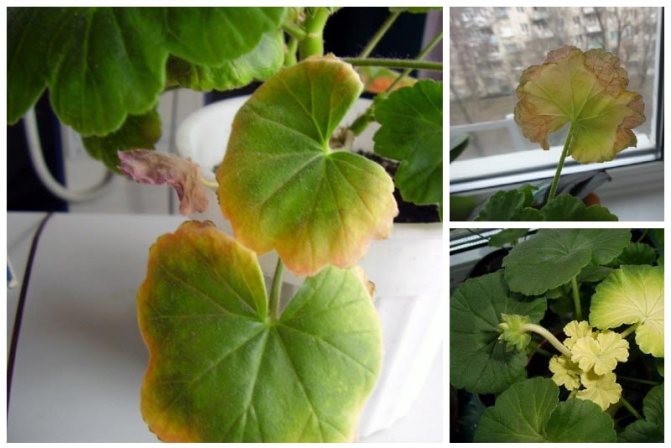

Lack of regular watering
Indoor geranium is capricious with regard to watering. It does not tolerate a lack of moisture, it is bad for waterlogging. You need to find a compromise: water the soil when it dries up to 2.5 cm. If this is difficult to track, then mulching the soil would be a good option. For this, pine bark, peat, crushed stone, tea, moss, marble chips are suitable. The time between waterings will increase, there will be no risk of spreading rot, and it will be possible to prevent yellowing of the leaves.
Incorrectly selected soil
In order for the roots of pelargonium to grow well, a special loose fertile soil mixture is needed. You can buy it at the store. The soil collected from the yard or forest may not be suitable for indoor geraniums, and will cause poor development and lack of flowering.
High air humidity
Not only the root system, but also the leaves are sensitive to excess water.
Do not spray on the plant from a spray bottle. This will negatively affect the color of the greenery, it may turn yellow.
Heat
Indoor geranium grows best at a temperature of +20 ° C. High degrees give yellowness on the leaves.This happens especially often in winter, when heating radiators strongly heat the air near the windowsill on which the plant stands. With a cold snap, the development of pelargonium slows down, flowering is delayed. She prepares for withering away.
Lack of fertilizer
Active growth and vigorous flowering require good feeding. This requires iron, phosphorus, potassium. It is necessary to add nutrients regularly once a month. You can buy a low nitrogen, all-purpose indoor flowering plant mix.
Ingress of herbicides
When the leaves turn yellow and dry, indoor geraniums are likely to be exposed to chemicals such as weed control drugs. Pelargonium is sensitive to household hygiene and cosmetics products - air fresheners, hair sprays.
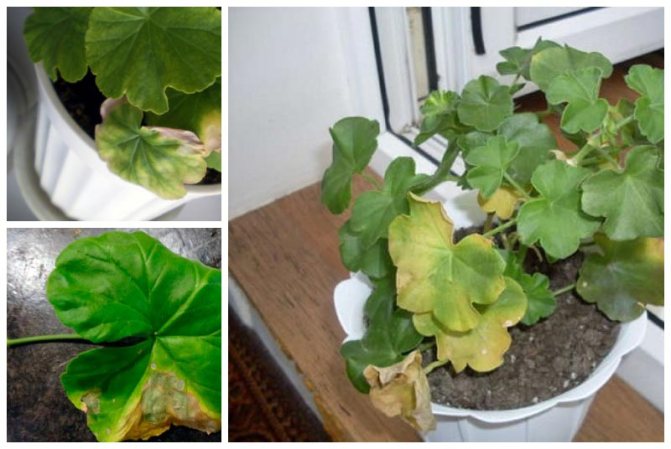

Drafts
Indoor geraniums are often placed on windowsills. Not surprisingly, this beautiful plant is always pleasing to the eye. But regular airing damages the appearance of pelargonium. The leaves begin to turn yellow and dry, gradually all fall off. You can fix the situation by choosing a place without wind.
Poor or no drainage
To drain excess moisture from the root system, there must be a drainage layer in the pot. In its absence, the process of decay begins, which gradually destroys the entire plant. Its beginning can be identified by the leaves. They start to turn yellow for no apparent reason.
Why does the plant wither?
Let's take a closer look at the reasons why geraniums can start to wither.
Lack of light
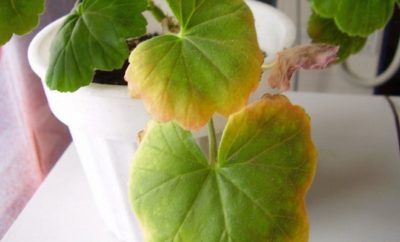

With a lack of lighting, the stem stretches out, and the lower leaves begin to turn yellow and dry. As a result, the indoor pet blooms little and rarely. In this case, the pot must be rearranged closer to the light or additional lighting in the form of lamps must be added. The leaves do not need to be touched, otherwise only a bare stem will remain.
In order for the geranium to start growing wider, you can pinch the top of its head. If it was not possible to rehabilitate the plant in time, then the only option remains - cutting cuttings and rooting.
Sunburn
If you notice that the leaf plates began to turn yellow, and then turn white and dry, then the flower has received a sunburn. Geranium is very fond of light, but direct sunlight is very dangerous for it.
On hot summer days, be sure to shade the flower curtain or white paper, or remove the pot from the windowsill onto a nearby cabinet.
Excess moisture in a flower pot
In the case of an excess of moisture, the leaves begin to turn yellow at the tops of the shoots, become lethargic and watery. As a result, if you do not take action, the stem will rot and the leaves will dry out.
The drain holes must not be blocked by anything. For prevention, you can transplant the plant into another pot. Also, a tropical crop must be properly watered. Before the next watering, all the soil must be dry - not just the top. You can check the soil for dryness with an ordinary wooden stick.
Read also What kind of cabbage is sauerkraut made from?
Water scarcity
Geranium loves regular hydration. The main signs that there is not enough water are a dry yellow-brown border and pigmentation all over the plant.
Water the flower as soon as the soil in the pot is completely dry.
Low temperature content
When the exotic young lady begins to freeze, a red border appears on her leaves, which then turns yellow and dries.
Observe the temperature regime. Especially in the winter. Move the plant away from radiators and drafts. Or, cover the batteries with a thick blanket, towel, ridding your pet of dry air. The shoots and leaves of the flower should not touch the window pane.
Fungal diseases


Yellow spots that grow over the entire surface of the leaves are a sign of a fungal disease (for details on the most common causes of geranium ailments, read here, and from this article you will learn about plant leaf diseases).The leaf plates dry out over time, and the fungus affects the entire flower. It is necessary to start treatment as early as possible. Spray with a suitable fungicide.
Young geraniums can be completely dipped in a medicinal solution. Spray the adult plant thoroughly.
If the fungus has already infected the stem, then fungicides will not help. Both the plant and the soil must be disposed of, and the pot must be disinfected with a solution of potassium permanganate or boiling water.
Pests
Parasites can damage any part of a tropical crop. Small yellow dots will appear on the leaves. On the shoots, cobwebs and sticky deposits can be found. Uninvited guests can also be detected visually. Pests suck out all the nutrients and vitality from the flower, and often carry bacteria and spores of pathogenic fungi.
- You can wash the leaves with a solution of household or potassium soap.
- You can treat the plant with any complex action insecticide.
For prevention, it is recommended to repeat the treatment after a while.
Tightness
It is enough to transplant a tropical culture every 3-4 years. But if the flower grows quickly, then it needs a larger dwelling. In this case, transplant the indoor beauty into a slightly larger pot - do not overdo it with the size. Otherwise, you will not see flowering for a couple of years. Instead of foliage and buds, it will grow the root system.
After transplanting, you do not need to feed geraniums for three months.
Twisting reasons
Geranium leaves can curl downward for a variety of reasons, but in most cases they are associated with care errors.
Food
Fertilizing plays a very important role in a healthy diet of pelargonium. The plant responds well to nitrogen-containing additives, thanks to which the foliage becomes lush and beautiful, but the leaves respond to the deficiency of this element by curling. However, keep in mind that with an excess of the element, geranium directs all its forces to the growth of green mass and simply stops blooming.
Excess potassium is another common cause of twisting, so it is best to follow the instructions carefully when applying any fertilizer.
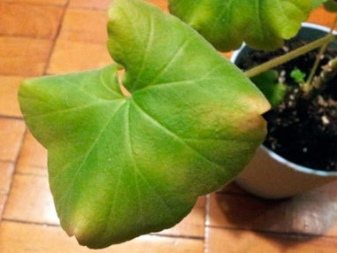

Air
Geranium is an undemanding plant in terms of keeping conditions, but a violation of temperature and humidity levels can cause problems with the foliage of this amazing flower. The optimum temperature for normal growth and development of a flower is considered to be + 20– + 25 degrees, and in winter the temperature can drop to +16 degrees. If the room is colder, then all life processes slow down so much that the flower does not have the strength to maintain normal photosynthesis and the healthy state of the leaf plates.
Geranium does not tolerate sudden temperature fluctuations, as well as direct sunlight and drafts. - it immediately responds to all these unfavorable factors by folding. The level of humidity typical for an ordinary living space is quite enough for a flower, but too dry air has a detrimental effect on it, so it is worth keeping it away from radiators and other heating devices. If it is not possible to find another place, then you should put a mini-fountain near the flower and periodically spray the air next to the pelargonium from a spray bottle.


Poorly matched pot
A very common mistake in caring for geraniums is choosing the wrong container. Usually, the flower is planted in a too large flowerpot, in this case, waterlogging often begins in the layers of soil mixture, untapped by the roots, which inevitably leads to twisting and death of the flower. Too small a pot is also contraindicated for a plant. As the plant grows, the roots become cramped, as a result, the flower does not receive nutrients.
If the pot is not replaced in a timely manner with a more voluminous one, then the foliage loses its decorative appearance and curls.
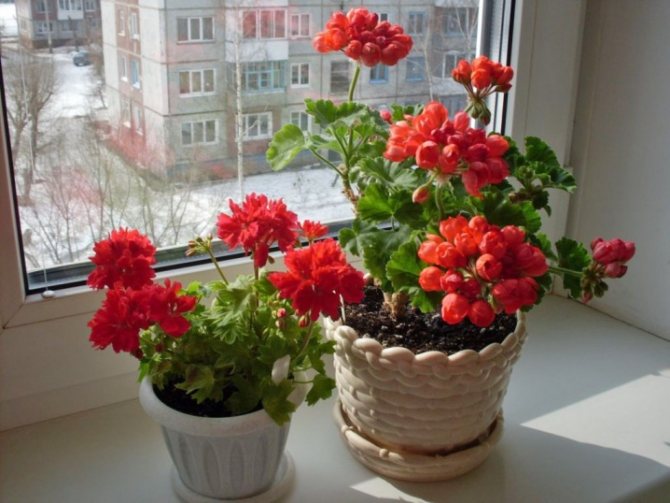

Diseases and pests
Pelargonium quite often becomes a victim of a spider mite attack, which causes the leaf plates to curl inward. This pest is almost impossible to identify with the naked eye. It is too small, but thin, whitish cobwebs on the back of the leaves can become a signal for geranium infection. Plants are often parasitized by aphids and whiteflies - in case of infection, geranium must be treated with an insecticide. Usually several treatments are required at intervals of 7-10 days. Much more dangerous for pelargonium is a viral infection, in which the leaves curl up, become clumsy - such diseases are not cured, therefore, at the first signs of damage, the plants must be thrown out in order to avoid infection of other indoor crops.
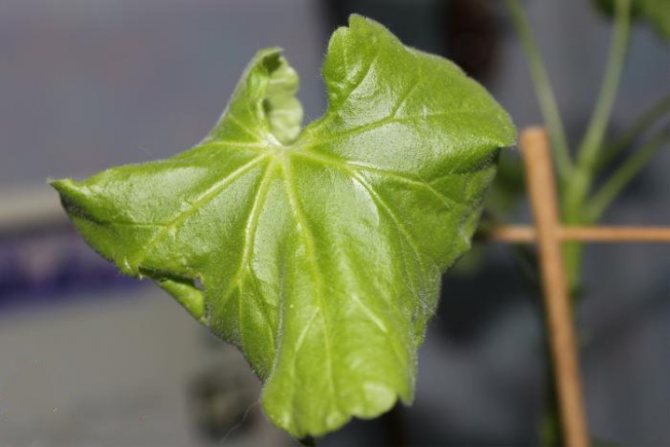

If the curling of the leaves is accompanied by the appearance of white bloom or small spots on the back of the leaves, most likely you are dealing with fungal diseases.
Prompt spraying with Bordeaux liquid can help the plant. Usually, after such a manipulation, the spots disappear, and the leaves return to their original shape. If ordinary garden soil is used to grow pelargonium, then parasite larvae and earthworms can get into the container with it, to combat them, the following means are used:
- "Aspirin" - 1 tablet per 10 liter, this solution is sprayed with the flower monthly;
- "Marathon" - a good remedy for aphids and whiteflies; the agent is sprayed dry on the substrate, then irrigated abundantly;
- Monterey - the drug is used in the presence of caterpillars.
Pelargonium fungus infection
This is a rare occurrence of leaf curling, but it can sometimes happen. Leaves infected with a fungus, in addition to curling, will be covered with spots or white bloom. In this case, you need to quickly treat pelargonium with a special preparation, for example, Bordeaux liquid. Geranium medicine can be purchased at a flower shop.
So, there are several reasons why pelargonium leaves curl and fall off. This alarm cannot be ignored. It is imperative to either reduce or increase watering, or to rid the geranium of the fungus. If you react in time to the problem of twisted leaves, then geranium will quickly recover, and again will delight the eye with abundant, long flowering.
What makes geranium leaves curl?
- It so happens that geranium leaves curl.
This must be fought until the plant is completely gone.
Usually, if the leaves of a plant are curled, then this is the protection of the plant from excess moisture evaporation. This happens when the leaves are in direct sunlight, the plant is in a very warm place or is watered a little.
Unbalanced feeding of pelargonium often also leads to curling of e leaves.
- So far, everything is fine with the geranium. Although I am also afraid of heating .. Pay attention if there is a tick on the inside of the sheet, maybe it’s him. And is there a flower close to the battery? Geranium does not like dry air, high temperatures. Often watering is also not worth it, as well as wiping the leaves. But the main thing is to exclude parasites, of course.
- Geranium is a rather unpretentious and calmly growing houseplant, it does not bring trouble, but sometimes problems arise.
For example, rolling leaves, this problem has a variety of solutions, only first you need to find out the reason for this.
1) This is a common sunburn.
2) Lack of watering, with a lack of moisture, the leaves dry and curl.
3) We went too far with fertilization, most often it is potassium.
4) The air is too dry, there is a battery nearby.
5) Lack of nitrogen fertilizer.
6) Your flower may have spider mites.
7) The appearance of a fungus on the soil.
And of course the simplest thing is too small a pot, it's time to urgently transplant the flower.
- This can happen due to a lack of micronutrients. For example, boron or calcium.With a lack of these elements, the leaves can remain green, albeit slightly changing the shade, but not yellow, but at the same time the corners begin to bend. So, you can buy fertilizer and feed the plant.
- The reason may be a small pot, as a result of which the geranium roots are uncomfortable and reflected on the leaves, you need to transplant into a wider pot.
Do not pour a lot of water into the plant, observe the temperature regime, do not put it next to the battery and in a draft, do not overdry the soil with occasional watering.
If the plant is affected by a fungus, then it should be treated with Bordeaux liquid.
info-
REASONS WHY GERANIUM LEAVES ROLL If the leaves curl from the bottom, it means that the geranium lacks such an element as nitrogen. from is considered a very important chemical element in plant life. Nitrogen participates in many chemical processes, and, thanks to this element, the plant has a beautiful and lush foliage with a rich green color. If there is not enough nitrogen, then the plant does not look good. However, an excess of nitrogen also negatively affects the plant, especially the flowering one. As a result, the plant begins to grow fat, leaves will actively develop, but there will be no flowers at all, or very few. Often leaves curling can begin due to an excess of potassium. This substance is vital for the plant, since thanks to it the plant receives nutrition and has the ability to stock up on the necessary substances. But an excess of potassium is harmful. Lack of light In geraniums, leaf curling can also begin for other reasons, for example, due to light. In many books on floriculture, they write that geranium easily tolerates direct sunlight. However, from my own experience, I want to say that this is not always true. It is better to provide the plant with diffused light. By the way, the leaves can curl from dry air and high temperatures. Geranium loves coolness more than heat. Improper Watering Watering can also play a role, good or bad. For example, if a geranium lacks moisture, then its leaves begin to curl, due to which the evaporation of moisture is delayed. Due to the constant overflow, problems can also begin, since due to excess moisture, the earth is compacted and almost no air reaches the roots. geranium should be poured only when the top layer of the earth dries out. After watering, try to loosen the soil. Pests The most dangerous causes of leaf curling are diseases and pests. If you notice that something is wrong with the leaves, be sure to inspect the plant carefully from all sides, whether there is any sign of pests (mites, for example) on it. All these living creatures settle on flowers and begin to suck out all the juices from them. Fortunately, it is possible to get rid of pests today, since there are powerful drugs on the market. It is enough to process the plants several times and there will be no trace of insects. True, it is a little more difficult to get rid of ticks, since their larvae are very tenacious and begin to develop in favorable conditions. Diseases The most unfavorable cause of leaf curling can be a viral disease. Unfortunately, it is very difficult to get rid of viral diseases, sometimes even impossible. It is often best to get rid of the plants to keep the infection from spreading. Not only twisted leaves speak of a viral disease. Symptoms such as ugly flowers are also present here, they look like torn. And the leaves become curly and even young. Sometimes the leaves can curl because the pot has become cramped in which case the plant needs to be transplanted. If you took soil on the site for planting geraniums, then it is possible that there are earthworms, which can cause leaves to curl, or the larvae of other living creatures. In this case, the plant will have to be transplanted. Now you know why geranium leaves curl.Perhaps there are more reasons, but I only know these, if you know other reasons, I will be glad if you share them.
Reproduction and transplantation
Reproduction is available in several ways.
Pelargonium can be propagated by seeds and cuttings
Seeds: how to care
Growing from seeds is easy enough. It is better to buy seeds in the store, in this case they will give a higher germination rate than those collected on their own.
Plant them into loose soil to a depth of 2 cm
... Moisten from above with water, it is better to do this from a spray bottle so as not to wash out the ground. The soil must first be disinfected, for which it is spilled with a light solution of potassium permanganate.
The seed pot is covered with glass to create even moisture. The most favorable temperature for seed germination is 18-22 degrees. After the emergence of seedlings, the glass is removed, and the temperature is lowered to 16-22 degrees.
After about 1.5-2 months, when 3 true leaves appear, pelargonium is transplanted to a permanent place. When she has 5-6 leaves, the plant is pinched for better branching.
Blooms
with this breeding method
in about six months
.
Growing by cuttings
This breeding method is not difficult. Geranium cuttings can be cut at any time of the year, but the best period is still spring. The stalk is taken 5-7 cm in size. To prevent the cut from rotting, it is sprinkled with crushed charcoal.
Then they are planted in a loose substrate or wet sand. They do not need shelter from above. When roots appear, pelargonium transplanted to a permanent place
... Flowering is possible in three months.
Landing
This plant does not particularly like transplants, and there is no need for them. This should be done only if the roots begin to sprout from the drainage hole. The planting container is taken 2 cm larger than the previous one. Geranium does not like too spacious pots and blooms worse in them, but gives a lot of shoots.
Young shoots that have reached 7 cm pinch to achieve branching
... Pruning is carried out in the fall, leaving the stem with 6-7 leaves. Periodically, you should remove excess shoots that grow from the sinuses, and not from the root.
If during the winter period pelargonium has grown strongly, in spring it can be cut off, so the flowering will be better. Periodically, the shoots should be pinched at a height of 4-5 leaves.
Transfer
Only necessary if the pelargonium has become too cramped. This is done in autumn or spring, avoiding the flowering period.
Potassium permanganate helps to disinfect the soil
- Preliminary a new container is being prepared
, a couple of centimeters larger than the previous one. If the pot is earthenware and new, it must be soaked in water for several hours so that it is saturated with moisture. - The soil is being prepared. If the soil was taken from the garden, it should be disinfected by spilling it with potassium permanganate or holding it in a hot oven for several minutes.
- During transplanting, the soil should be slightly damp, so it will be easier to remove the plant from the pot.
- Hold the geranium with one hand, turn the pot over and, gently tapping, remove the plant. It's better not to disturb the roots
, slightly remove the top layer, place the whole lump in a new pot and add fresh earth.
Geraniums are transplanted every two to three years and only if the pelargonium has grown strongly.
Growth features
A tropical indoor beauty loves a lot of light, therefore, for active growth and flowering, it must be placed in well-lit places. On hot summer days, do not forget to shade the flower from direct rays to avoid sunburn. In winter, use additional lighting.
Ventilate the area regularly, avoiding drafts.
The most an important procedure in the care of a tropical crop is regular and abundant watering. Especially often, at the first signs of dry soil, it is necessary to water the plant in the summer.
Care rules
When the reason that the leaves of the geranium curl is identified, it is necessary to begin to eliminate the negative factor. In the future, the following care recommendations must be observed:
- Conduct timely watering and loosening of the soil. Avoid waterlogging.
- Regularly provide plant nutrition with nutrients.
- Locate in favorable conditions, depending on the season.
- Transplant geraniums into a larger pot when the previous one becomes small.
- During transplanting, top up with new soil containing nutrients. You can buy soil in the store; manufacturers produce special formulations that are suitable for a particular type of flower.
- Check leaf plates for pests and unusual changes.
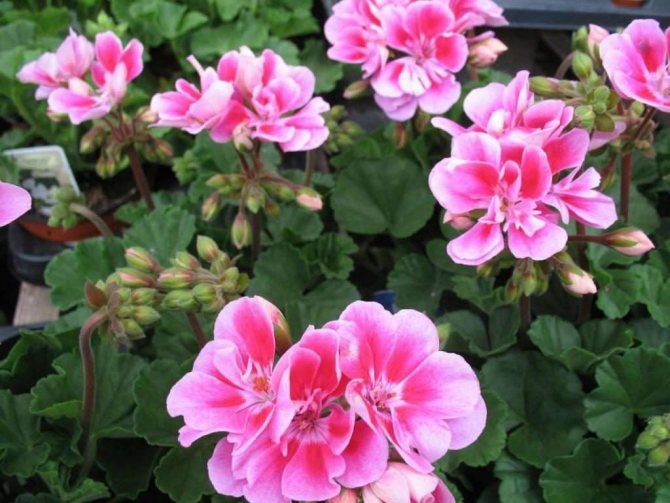

The information presented in the article will help determine the cause of leaf curling in geraniums and solve the problem with the appropriate method. The plant does not require special care, but a minimum amount of attention will ensure its vigorous growth and abundant flowering. Also read our article "What is the difference between geranium and pelargonium."
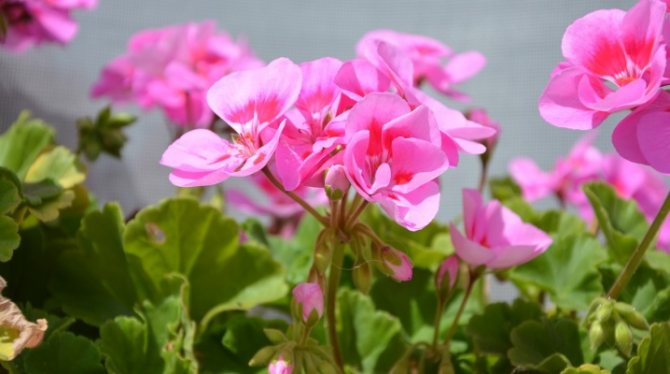

Pelargonium is a popular plant widely used in indoor and garden landscaping. Many call it geranium, but from the point of view of botany, this is not entirely true - although pelargonium belongs to the geranium family, nevertheless, it is a completely different species. However, it is this name that is popularly accepted, therefore, for convenience, within the framework of our article, we will continue to use this word in the text.
Why do the leaves curl inward?
The reasons can be different, the main thing is to find the right one and correct the error.
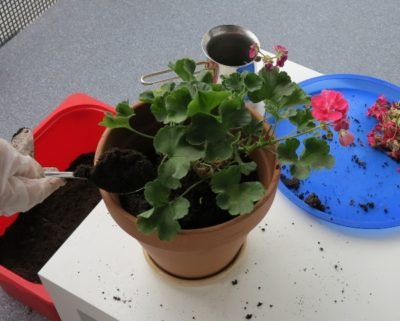

Food... Top dressing plays an important role in the correct and healthy development of geraniums. In particular, nitrogen makes the foliage of the plant beautiful and lush, and if for some reason it is not enough, the leaves wither and curl, but with an excess of this element, geranium stops blooming.
Read also: What to do with ash in the country
Excess potassium can also cause foliage to curl. It is necessary for the plant to obtain nutrients, but it is important to monitor its dosage. Air. The reason for this state of the flower can also be a violation of temperature and humidity. Geranium loves light, but is afraid of direct sunlight, so the leaves, protecting themselves from them, can curl up.
The plant does not tolerate dry air poorly, so you should not place it in a hot place and near heating appliances, and if there is no other way out, you need to put a container of water near the geranium and spray the air next to it.
- Pot. One of the most common mistakes is choosing the wrong flowerpot. Often geraniums are initially planted in too large a container, or, conversely, they are in no hurry to transplant into a larger pot. Along with the growth and development of the flower, its root system also grows, which means that over time it becomes little space in the flowerpot and needs to be replaced with a more spacious one. If this is not done, the leaves will lose their healthy appearance and begin to curl.
- Diseases and pests. Despite the resistance of geraniums to diseases and pests, there is no guarantee that the plant will never get sick or attacked by insects (what leaf diseases are found in geraniums?).
- The soil. It is impossible to grow a healthy flower in the wrong soil. The soil for geraniums should be light, have a neutral or slightly acidic reaction, and river sand and peat should be present in the composition.If the soil is prepared independently, and is not purchased in the store, mineral fertilizers and humus should be added to it.
If the leaves of an indoor or garden flower for some reason curl, and spots or white bloom appear on them, these are symptoms of a fungus infection. In such a situation, the plant should be treated with Bordeaux liquid.
Pests such as worms, ticks, and aphids can also provoke leaf curling. You can get rid of them by treating the geranium with a special product purchased at a flower shop.

